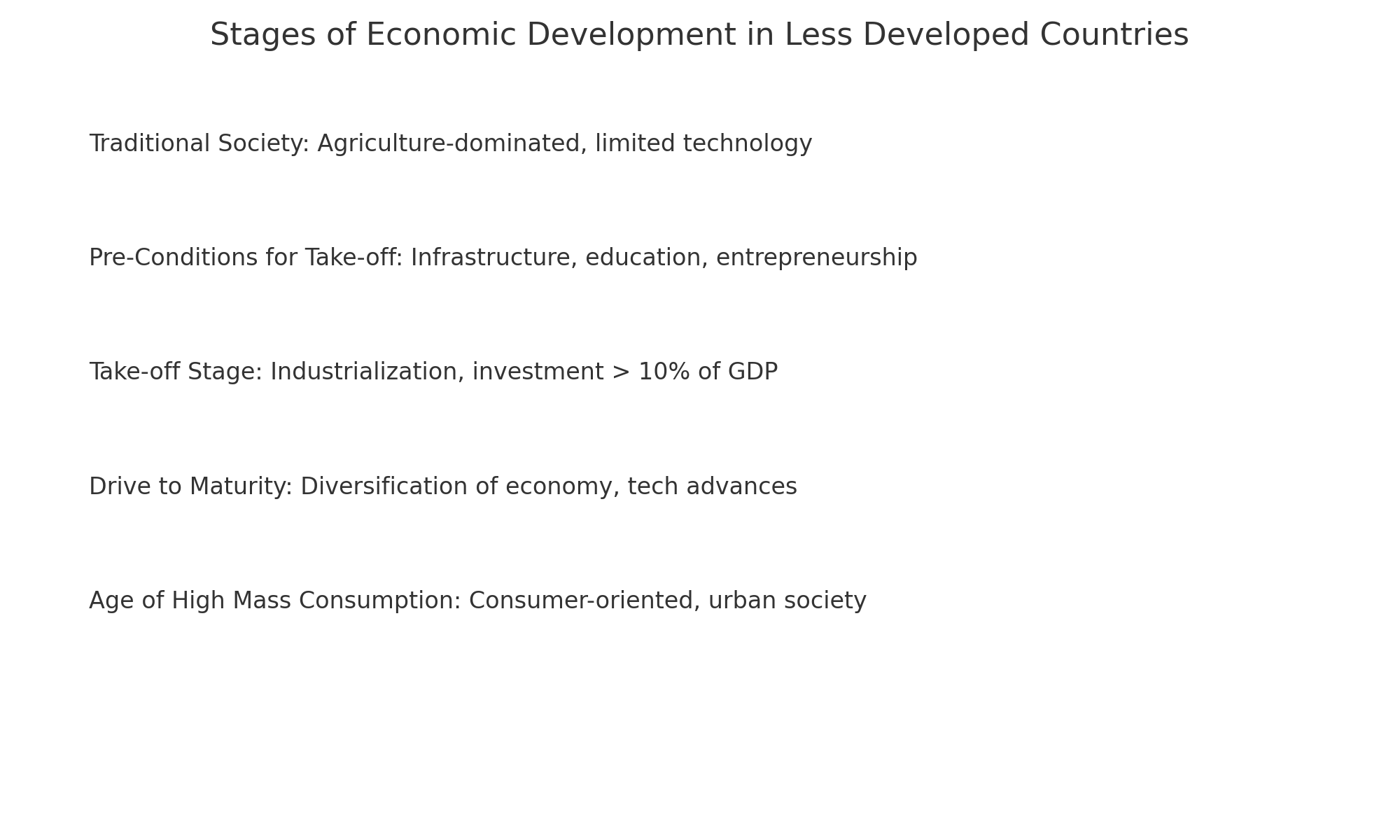
27 Jul Process of Economic Development of Less Developed Countries
Process of Economic Development of Less Developed Countries (LDCs) – UPSC Economics Optional Paper 1
Understanding the economic development of less developed countries (LDCs) is vital for UPSC aspirants choosing Economics as their optional subject. This topic falls under Paper 1 of the UPSC Economics Optional syllabus and intersects with development economics, planning strategies, and structural transformation. This comprehensive guide covers the theoretical foundations, strategies adopted by LDCs, structural issues, and critical analysis backed by real-world examples.
📊 Infographic: Stages of Economic Development in LDCs
🧠 Mind Map: Factors Influencing Economic Development in LDCs
ldc development mindmap
1. Meaning and Characteristics of LDCs
LDCs or Less Developed Countries are nations with low per capita income, poor infrastructure, high poverty, and underdeveloped industries. They are mostly found in regions of Sub-Saharan Africa, South Asia, and parts of Latin America.
Common Characteristics:
- Low per capita income
- High dependence on agriculture
- High population growth
- Poor health and educational outcomes
- Weak industrial base
- Technological backwardness
- Institutional and infrastructural deficiencies
GS paper 4 syllabus and study plan
GS paper 3 syllabus and study plan
GS paper 2 syllabus and study plan
GS paper 1 syllabus and study plan
2. Difference Between Growth and Development
While growth focuses on quantitative expansion (increase in GDP), development includes qualitative changes like structural transformation, reduction in poverty, better education, and health outcomes.
| Economic Growth | Economic Development |
|---|---|
| Increase in output or income | Increase in output + improvement in quality of life |
| Measured in GDP terms | Measured by HDI, inequality, poverty indicators |
| Does not include structural changes | Includes structural and institutional changes |
3. Theoretical Approaches to Economic Development
a. Linear Stages Theory
Inspired by the historical experience of developed countries, this theory argues that development follows a linear sequence.
- Rostow’s Stages: Traditional Society → Pre-conditions → Take-off → Drive to Maturity → Mass Consumption
- Harrod-Domar Model: Emphasizes investment and capital-output ratio
b. Structuralist Models
- Dualism: Arthur Lewis Model (Traditional vs Modern Sector)
- Structural Change Model: Focus on transforming economic structure from agrarian to industrial
- Kuznets’ Hypothesis: Inequality rises then falls with development
c. Dependency and Neo-Marxist Theories
Argue that underdevelopment is perpetuated by global capitalism and trade structures. LDCs are exploited through unequal exchange and capital flight.
d. Endogenous Growth Theories
- Romer and Lucas highlight the role of human capital, R&D, and institutions
- Relevance for LDCs in designing education and innovation policies
4. Structural Constraints Faced by LDCs
- Low levels of human capital: Poor health, low literacy, skill gaps
- Inadequate infrastructure: Transport, electricity, digital divide
- Financial constraints: Low domestic savings, reliance on aid/FDI
- Political instability and weak governance
- High population growth and underemployment
5. Policy Strategies for Development in LDCs
a. Planning and State-led Development
- India’s Five-Year Plans as examples
- Emphasis on public sector, import substitution, capital accumulation
b. Trade Strategies
- Import Substitution Industrialization (ISI)
- Export-led Growth (e.g., East Asian Tigers)
c. Investment in Human Capital
- Universal education and primary healthcare
- Skill development for productivity enhancement
d. Rural Development and Agricultural Reform
- Land reforms, irrigation, credit access, MSPs
- Technology diffusion through extension services
e. Role of Institutions
Effective bureaucracy, corruption control, legal systems, and property rights directly impact investor confidence and development outcomes.
6. Role of Foreign Aid, FDI, and Global Institutions
LDCs often rely on external finance for development, which includes:
- Official Development Assistance (ODA)
- Loans from IMF, World Bank
- FDI and Technology Transfer
However, these inflows come with conditionalities that may not always align with local priorities.
7. Sustainable and Inclusive Development
LDCs are now expected to achieve development while addressing climate change, inequality, and inclusiveness.
- Green economy transition
- Gender equity and marginalized communities
- Adoption of Sustainable Development Goals (SDGs)
8. India as a Case Study
India’s transition from a low-income agrarian economy to one of the largest economies in the world provides valuable insights:
- Importance of mixed economy model and state planning
- Liberalization of 1991 as a turning point
- Challenges: Income inequality, informal sector, unemployment
📝 Previous Year Questions (PYQs) – UPSC Economics Optional
- Discuss the process of economic development in LDCs with reference to structural transformation. (2022)
- Critically evaluate the Lewis model of development with unlimited supply of labor. (2020)
- Explain the relevance of Rostow’s stages of growth in the context of Indian economy. (2019)
🔮 Probable Questions for UPSC Prelims and Mains
- Explain the difference between economic growth and economic development with examples from LDCs.
- How does institutional quality influence economic development in less developed countries?
- Examine the relevance of endogenous growth models for LDCs.
- Critically assess the success of planning as a strategy for development in LDCs.




No Comments